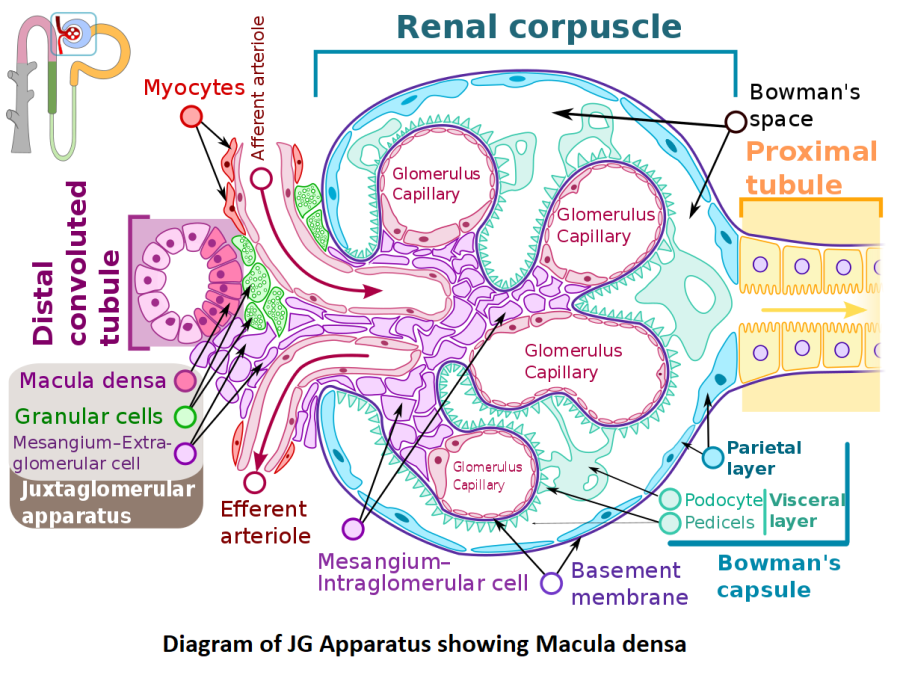
What is Macula Densa?
Answer
467.1k+ views
Hint: Juxtaglomerular apparatus is the part of the nephron and helps control the functions of the nephron. The juxtaglomerular apparatus gets its name from the fact that it is located right next to (juxta) the glomerulus. It is formed at the junction of DCT and the afferent arteriole. It controls glomerular filtration rate by controlling the renal blood flow.
Complete solution:
The macula densa is a densely packed specialized cell layer that lines the wall of the distal tubule at the place where the thick ascending limb of the Loop of Henle meets the distal convoluted tubule in the kidney.
The thickening where the distal tubule meets the glomerulus is known as the macula densa.
The concentration of sodium chloride in the distal convoluted tubule affects the cells of the macula densa. When the concentration of sodium chloride in the blood drops, the macula densa sends out a signal that has two effects:
It lowers blood pressure in the afferent arterioles, raising glomerular hydrostatic pressure and assisting in the restoration of the glomerular filtration rate (GFR) to normal.
It promotes renin release from the juxtaglomerular cells, which are the principal renin storage sites.

Note:
The macula densa cells contract the afferent arteriole in response to increased salt, lowering blood flow to the glomerulus and the glomerular filtration rate. When blood pressure in the afferent arteriole lowers, the juxtaglomerular cells of the afferent arteriole, which are derived from smooth muscle cells, emit renin. Rennin activates Rennin angiotensin aldosterone system which increases blood pressure.
Complete solution:
The macula densa is a densely packed specialized cell layer that lines the wall of the distal tubule at the place where the thick ascending limb of the Loop of Henle meets the distal convoluted tubule in the kidney.
The thickening where the distal tubule meets the glomerulus is known as the macula densa.
The concentration of sodium chloride in the distal convoluted tubule affects the cells of the macula densa. When the concentration of sodium chloride in the blood drops, the macula densa sends out a signal that has two effects:
It lowers blood pressure in the afferent arterioles, raising glomerular hydrostatic pressure and assisting in the restoration of the glomerular filtration rate (GFR) to normal.
It promotes renin release from the juxtaglomerular cells, which are the principal renin storage sites.

Note:
The macula densa cells contract the afferent arteriole in response to increased salt, lowering blood flow to the glomerulus and the glomerular filtration rate. When blood pressure in the afferent arteriole lowers, the juxtaglomerular cells of the afferent arteriole, which are derived from smooth muscle cells, emit renin. Rennin activates Rennin angiotensin aldosterone system which increases blood pressure.
Recently Updated Pages
Why are manures considered better than fertilizers class 11 biology CBSE

Find the coordinates of the midpoint of the line segment class 11 maths CBSE

Distinguish between static friction limiting friction class 11 physics CBSE

The Chairman of the constituent Assembly was A Jawaharlal class 11 social science CBSE

The first National Commission on Labour NCL submitted class 11 social science CBSE

Number of all subshell of n + l 7 is A 4 B 5 C 6 D class 11 chemistry CBSE

Trending doubts
What is meant by exothermic and endothermic reactions class 11 chemistry CBSE

10 examples of friction in our daily life

One Metric ton is equal to kg A 10000 B 1000 C 100 class 11 physics CBSE

1 Quintal is equal to a 110 kg b 10 kg c 100kg d 1000 class 11 physics CBSE

Difference Between Prokaryotic Cells and Eukaryotic Cells

What are Quantum numbers Explain the quantum number class 11 chemistry CBSE




